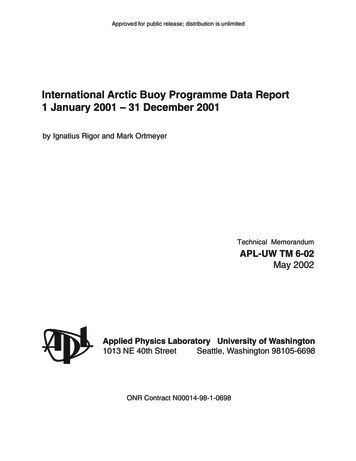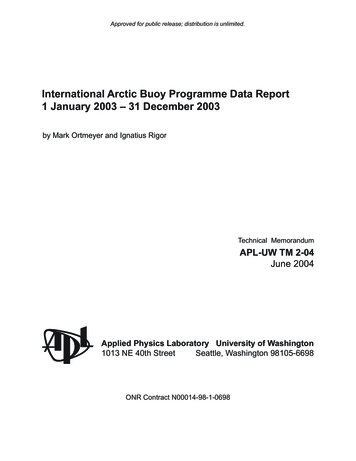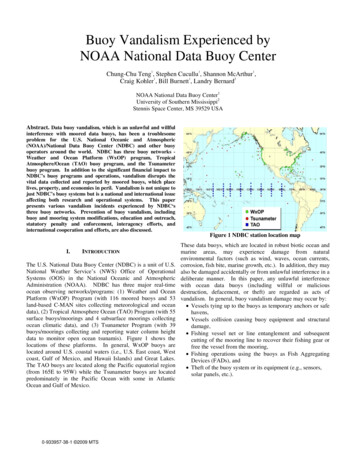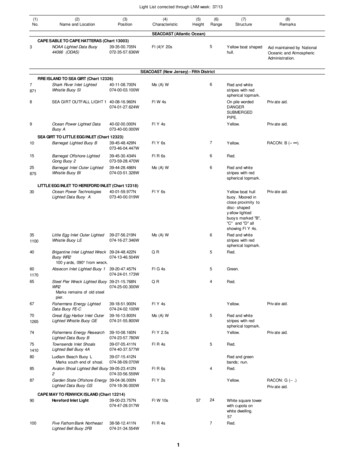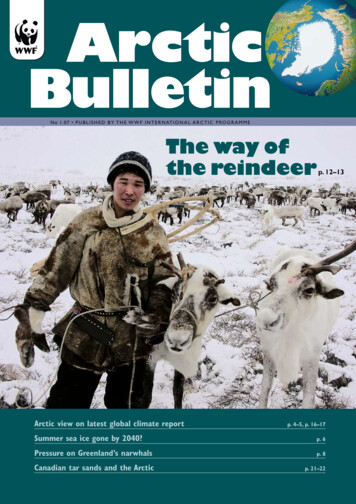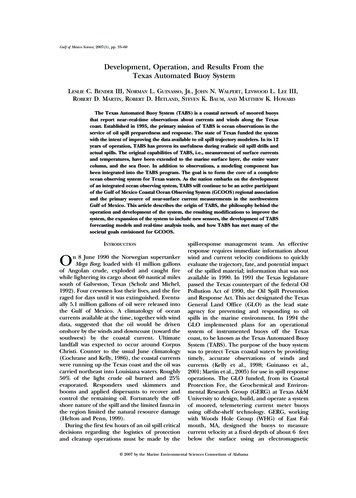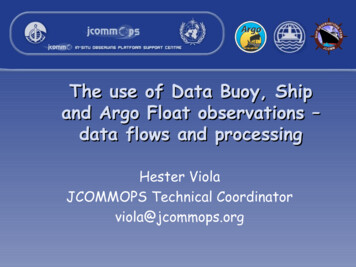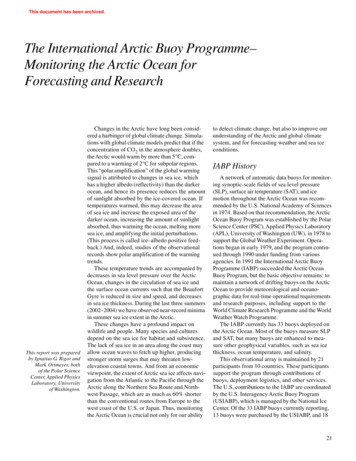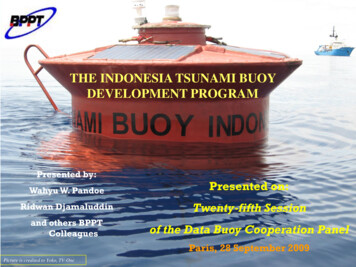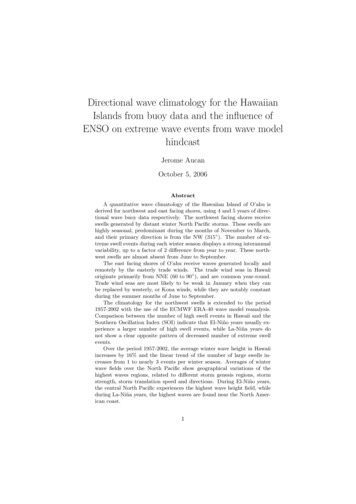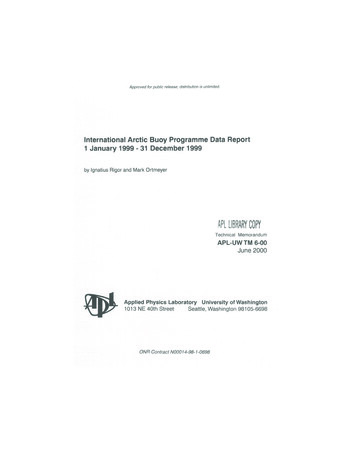
Transcription
International ArcticInternationalArctic BuoyBuoy ProgrammeProgramme 1999- -2 -
ACKNOWLEDGMENTSThe International Arctic Buoy Programme (IABP) is self-sustaining, supported bycontributions in the form of equipment, services (such as communication, deployment,archiving, scientific, and technical advice), coordination, and money. The United StatesInteragency Arctic Buoy Programme (USIABP), among its several contributions to theIABP, funds the position of IABP Coordinator. The authors are grateful to David Benner,of the U.S. Navy/NOAA National Ice Center and Chairman of USIABP, for his continuedsupport of the data handling portion of the IABP. Preparation of this report and archivingof the data were funded through ONR contract N00014-98-1-0698.Participants of the International Arctic Buoy ProgrammeAlfred Wegener Institute for Polar and Marine ResearchArctic and Antarctic Research InstituteArctic Centre, University of LaplandCanadian Coast GuardChristian Michelsen Research InstituteEnvironment CanadaInstitute of Ocean SciencesInstitute of Oceanology, China Academy of SciencesJapan Marine Science and Technology CenterMarine Environmental Data ServiceNansen Environmental and Remote Sensing CentreNorske PolarinstituttNorwegian Meteorological InstitutePacific Marine Environmental Laboratory, NOAAPolar Science Center, Applied Physics LaboratoryRussian Federal Service for Hydrometeorology andEnvironmental MonitoringScott Polar Research InstituteService ArgosWoods Hole Oceanographic InstitutionU.K. Meteorological OfficeNaval Oceanographic OfficeNaval Meteorology and Oceanography CommandNavy/NOAA National Ice Center*World Climate Research Programme (WCRP) of theWorld Meteorological Organization (WMO/IOC/ICSU)* Representing several U.S. agencies.- ii - -1 JapanCanadaNorwayNorwayNorwayUSAUSARussiaUKFrance, USAUSAUKUSAUSAUSAInternational
TABLE OF CONTENTSI.Introduction . . . . . . . . . . . . . . . . . . . . . . . . . . . . . . . . . . . . . . . . . . . . . . . . . . . . . . 1II.Deployment Schedule . . . . . . . . . . . . . . . . . . . . . . . . . . . . . . . . . . . . . . . . . . . . . . 1III.Buoy Information . . . . . . . . . . . . . . . . . . . . . . . . . . . . . . . . . . . . . . . . . . . . . . . . . . 2A Argos Experiment Numbers and Program Contacts. . . . . . . . . . . . . . . . . . . . . 3B. GTS Headers . . . . . . . . . . . . . . . . . . . . . . . . . . . . . . . . . . . . . . . . . . . . . . . . . . 5C. Buoy Types . . . . . . . . . . . . . . . . . . . . . . . . . . . . . . . . . . . . . . . . . . . . . . . . . . . . 6IV.Data Processing . . . . . . . . . . . . . . . . . . . . . . . . . . . . . . . . . . . . . . . . . . . . . . . . . . 6V.Available Data Sets . . . . . . . . . . . . . . . . . . . . . . . . . . . . . . . . . . . . . . . . . . . . . . . . 6A. Data Set AB . . . . . . . . . . . . . . . . . . . . . . . . . . . . . . . . . . . . . . . . . . . . . . . . . . . 7B. Data Set C . . . . . . . . . . . . . . . . . . . . . . . . . . . . . . . . . . . . . . . . . . . . . . . . . . . . 7C. Data Set D . . . . . . . . . . . . . . . . . . . . . . . . . . . . . . . . . . . . . . . . . . . . . . . . . . . . 8VI.Tabular Data . . . . . . . . . . . . . . . . . . . . . . . . . . . . . . . . . . . . . . . . . . . . . . . . . . . . 10VII.Graphical Data . . . . . . . . . . . . . . . . . . . . . . . . . . . . . . . . . . . . . . . . . . . . . . . . . . 97VIII.Average Pressure Fields . . . . . . . . . . . . . . . . . . . . . . . . . . . . . . . . . . . . . . . . . . 159Appendix: Buoy Diagrams . . . . . . . . . . . . . . . . . . . . . . . . . . . . . . . . . . . . . . . . . . . . . 166--0iii- -
I.IntroductionA network of automatic data buoys to monitor synoptic-scale fields of pressure,temperature, and ice motion throughout the Arctic Basin was recommended by theU.S. National Academy of Sciences in 1974. Based on the Academy’srecommendation, the Arctic Ocean Buoy Programme was established by the PolarScience Center, University of Washington, in 1978 to support the Global WeatherExperiment. Operations began in early 1979, and the program continued through1990 under funding from various agencies. In 1991, the Arctic Ocean BuoyProgrammewas succeeded by the International Arctic Buoy Programme(IABP), butthe basic objective remains - to establish and maintain a network of drifting buoys inthe Arctic Ocean with which to provide data needed for real-time operations andmeteorological and oceanographic research.The IABP is funded and managed by participants of the program, includingoperational and research agencies, meteorological and oceanographic institutes,and government and nongovernmental organizations. The participants representnine countries and one international agency.This report is the nineteenth in a series of data reports beginning in 1979; itcovers the period from 1 January 1999 through 31 December 1999.II.Deployment ScheduleBuoys that continued to operate in 1999 and their year of deployment are asfollows:1992: 10667,106681996: 1261, 1556,19577,19579, 26693, 266991997: 1901, 1902, 2385, 2417, 7105, 22204, 266961998: 1301, 1351, 1793, 1904, 1905, 1906, 2159, 2388, 2416, 3004, 3690,3981, 4954, 5300, 8356, 8357, 9372, 14954, 14955Buoys deployed in 1999 are as follows:March:August:5313, 53141222, 3311, 3691, 5312, 8065, 20858, 20859-1-
III.Buoy InformationExpr ArgosNumber ID484 1222484 12611053 1301484 1351314 155629 1793557 1901557 1902557 1904557 1905557 19061053 23851053 23881053 24161053 24171053 3004919 3311314 3690314 36911053 4954627 5312627 5313627 5314695 7105919 8065282 83561016 106671016 10668919 149551053 195771053 195791053 208581053 20859695 222041053 266931053 266961053 26699GTS X12-KARSSSVX02-CWEGSSVX12-KARSSSVX02-CWEGDateWMO Data P T Buoy TypeDeployed IDBytesAug 99 48601 17 ICEX - AIRAug 96 48102 17 ICEX - AIRApr 98 48581 16 Metocean TOGAAug 98 48532 17 ICEX - AIRAug 96 48111 16ICEX - AIRAug 98 48533 17 ICEX - AIRAug 97 25521 21 ICEX - AIRAug 97 25522 21 ICEX - AIRAug 98 25524 21 ICEX-AIRAug 98 25525 21 ICEX-AIRAug 98 25526 21 ICEX-AIRAug 97 25549 17 ICEX - AIRSep 98 25557 32 CES / Zeno Ice BuoyApr 98 47523 32 ZENO-3200Sep 97 48572 32 CES - Zeno Ice BuoyAug 98 25535 17 ICEX-AIRAug 99 25569 21 ICEX-AIRAug 98 25011 17 ICEX-AIRAug 99 25012 21 ICEX-AIRApr 98 48580 32 ZENO-3200Aug 99 48523 17 ICEX-AIRMar 99 47538 16 ECMar 99 48521 16 EC GPSSep9732PMEL GPS BuoyAug 99 25570 21 ICEX-AIRJul 98 25537 12 AARI Air DropMay 92 48531 32IOEBMay 92 48531 32IOEBAug 98 25574 21 ICEX-AIRAug 96 47601 16 ICEX - AIRAug 96 48518 16 ICEX - AIRAug 99 48574 17 ICEX - AIRAug 99 48575 17 ICEX - AIRSep 9732PMEL GPS BuoyMar 96 48578 32 CES - Zeno Ice BuoySep 97 48576 32 CES - Zeno Ice BuoyJul 96 48573 32 CES - Zeno Ice Buoy-2-
A.Argos Experiment Numbers and Program ContactsExpr. No.:PGC:Telephone:Telefax:Expr. No.:PGC:Telephone:Expr. No.:PGC:Telephone:Telefax:Expr. No.:PGC:Telephone:Telefax:29Torgny VinjeChristian Michelsen Research InstituteFantoftvn 38P.O. Box 6031 PostterminalenN-5892, BergenNorway( 47) 2 12 36 50( 47) 2 12 38 54282Deborah BirdNaval Oceanographic Office1002 Balch BoulevardStennis Space Center, MS 39522-5001U.S.A.(601) 688-4242314Knut BjorheimNorwegian Meteorological InstitutePost Box 320 BlindernN-0313 OsloNorway( 47) 2 60 50 90( 47) 2 69 25 15484Lars GolmenChristian Michelsen Research InstituteFantoftvn 38P.O. Box 6031 PostterminalenN-5892, BergenNorway( 47) 55 32 56 40( 47) 55 32 88 83-3-
Expr. No.:PGCTelephone:Telefax:Expr. No.:PGC:Telephone:Telefax:Expr. No.:PGC:Telephone:Expr. No.:PGC:Telephone:557Ignatius RigorPolar Science CenterApplied Physics LaboratoryUniversity of WashingtonSeattle, WA 98105-6698U.S.A.(206) 543-6613(206) 616-3142627A. L. LukaweskyArctic Weather CentreEnvironment CanadaTwin Atria Bldg. 2nd Floor4999 98 AvenueEdmonton, Alberta T6B 2X3Canada(403) 951-8814(403) 468-7950695James OverlandPacific Marine Environmental LaboratoryNational Oceanic and Atmospheric Administration7600 Sand Point Way NEC15700Seattle, WA 98115-0070U.S.A.(206) 526-6795919Hartmut HellmerAlfred Wegener Institute for Polarand Marine ResearchPostfach 120161, D-27515 BremerhavenGermany( 49) 471 4831 794-4-
Telefax:( 49) 471 4831 797Expr. No.:PGC:1016T. NakanishiJapan Marine Science and Technology CenterOcean Research Department2-15, NatsushimaYokosuka 237-0061Japan(0468) 66-3811(0468) 66-0970Telephone:Telefax:Expr. No.:PGC:Telephone:Telefax:B.1053 & 9053David BennerNational Ice CenterFOB#4 Room 23014251 Suitland RoadWashington, DC 20395-5180U.S.A.(301) 457 5314 X 301(301) 457 5300GTS HeadersThe buoy data are distributed in real time on Global TelecommunicationsSystem (GTS) circuits using the WMO buoy format under the followingGTS headers:1. SSVX07 LFPW - Arctic buoy data from French (Service Argos) GlobalProcessing Center.2. SSVX12 KARS - Arctic buoy data from U.S. (Service Argos) GlobalProcessing Center.3. SSVX16 KARS - U.S. Naval Oceanographic Office (NAVOCEANO)Arctic buoy data from the U. S. (Service Argos) Global ProcessingCenter.4. SSVX18 KWBC - U.S. National Ice Center Arctic buoy data insertedby the U.S. National Weather Service.5. SSVX02 CWEG - Arctic buoy data from the Edmonton Local UserTerminal.6. SSVX01 LFPW - Arctic buoy data from French (Service Argos) Global-5-
Processing Center.7. SSVX04 KARS - Arctic buoy data from U.S. (Service Argos) GlobalProcessing Center.C.IV.Buoy TypesPlease refer to Appendix: Buoy Diagrams.Data ProcessingData for this report were processed as outlined in the 1986 data report with theexception that we have reverted to 3-hour interpolation of sea-level pressure and airtemperature. The average daily temperature was calculated from these eightmeasurements; an asterisk in the tabular data indicates that one or more of thesemeasurements were not available.V.Available Data SetsThe data sets begin with 0000 GMT, 1 January 1999, and end with 1200 GMT,31 December 1999.These data sets are available over the World Wide Web from the internet hosthttp://iabp.apl.washington.edu/, are archived at the World Data Center A:Glaciology, and can be obtained via anonymous FTP. Inquiries should be sent to thefollowing address:National Snow and Ice Data CenterCIRES, Campus Box 449University of ColoradoBoulder, Colorado 80309 U.S.A.Telephone (303) 492-5171-6-
A.Data Set ABTwelve-hour pressure and temperature fields. These data can be readwith the following FORTRAN statements:INTEGERREALREAD1 FORMATLYLMLDLHLATLONGPTEPETB.LAT, LD, LH, LONG, LM, LY, PX, PXX, PXY, PY, PYYEP, ET, P, T(,1) LY, LM, LD, LH, LAT, LONG, P, T, EP, ET, PX, PY, PXX,PXY, PYY(4I3, I4, I5, F8.1, F7.1, 2F5.1, 2I5, 3I6)is the year less 1900.is the month; 1 for January, 2 for February, etc.is the day of the month.is the hour in GMT; LH 0 or 12.is the latitude in degrees north.is the longitude in degrees east.is the interpolated pressure in millibars.is the interpolated temperature in degrees Celsiusaveraged from LH - 12 to LH 12 hours.is the interpolation error variance in millibars squared.is the interpolation error variance in degrees Celsiussquared.PX, PYare the pressure derivatives times 103 in the x and yPXX, PXY,directions. PX and PY have units of millibars per 103kilometers.are the interpolated second derivatives of pressure timesPYY106. Their units are millibars per 106 kilometers.Data Set CTwelve-hour buoy positions. These data can be read with the followingFORTRAN statements:INTEGERREALID, LD, LH, LM, LYLAT, LONGREAD1 FORMAT(,1) LY, LM, LD, LH, ID, LAT, LONG(4I3, I6, F7.3, F9.3)-7-
LYLMLDLHLATIDLONGC.is the year less 1900.is the month; 1 for January, 2 for February, etc.is the day of the month.is the hour in GMT; LH 0 or 12.is the latitude in degrees north.is the buoy identification.is the longitude in degrees east.Data Set DInterpolated ice velocity fields. This data set contains ice velocityestimates at a fixed grid of points. The data can be read with theseFORTRAN statements:INTEGERREALLAT, LD, LH, LM, LONG, LYDUDX, DUDY, DVDX, DVDY, SIGMA2, UX, UYREAD1 FORMAT(,1) LY, LM, LD, LH, LAT, LONG, UX, UY, SIGMA2, DUDX,DUDY, DVDX, DVDY(4I3, I4, I5, 2F7.1, F5.1, 4F8.2)LYLMis the year less 1900.is the month; 1 for January, 2 for February, etc.LDLHLATLONGUXis the day of the month.is the hour in GMT; LH 0 or 12.is the latitude in degrees north.is the longitude in degrees east.is the interpolated ice velocity in the x direction incentimeters per second.is the interpolated ice velocity in the y direction incentimeters per second.is the variance of the interpolation error in velocity, indimensionless units. No confidence should beplaced in interpolated velocities for whichSIGMA2 0.5.UYSIGMA2-8-
-9-
DUDX, DUDY,are interpolated velocity derivatives expressed inDVDX, DVDYCartesian coordinates. After multiplication by 10-7 thereported values have units of seconds-1.Note on Coordinates: The pressure and velocity derivatives are expressedwith respect to a rectangular coordinate system with the origin at the North Pole, thex axis coinciding with the Greenwich meridian, and the y axis with the 90 Emeridian. The transformation from latitude and longitude to x and y is as follows:x 110.949 (90 - lat) cos (long)y 110.949 (90 - lat) sin (long)where x and y are in kilometers and latitude and longitude are in degrees.The authors can be contacted at the address below:University of WashingtonPolar Science CenterApplied Physics Laboratory1013 N.E. 40th StreetSeattle, WA 98105 U.S.A.Telephone (206) 543-1300- 10 -
VI.Tabular DataThe tables give daily data for each buoy identified by its ARGOS number. Thedata are interpolated values for location and pressure at 1200 GMT. The value isnot given if it is not reliably known. The temperature is averaged over the eightsynoptic intervals to eliminate diurnal variation. An asterisk indicates that one ormore of the temperatures during that day were not known.- 11 -
BUOY 1222BUOY( 1222)99 02122232425262728293031BUOY( 1222)99 AT(N)LON( E,-W)SLP(MB)Air .20.3-0.5-2.4-1.70.10.5LAT(N)LON( E,-W)SLP(MB)Air .9-19.2-17.0BUOY( 1222)99 89101112131415161718192021222324252627282930BUOY( 1222)99 0321322323324325326327328329330331332333334- 12 30LAT(N)LON( E,-W)SLP(MB)Air ON( E,-W)SLP(MB)Air 5-16.8-21.8-25.1-23.5-17.2-18.9
BUOY 1222BUOY( 1222)99 AT(N)LON( E,-W)SLP(MB)Air 24.6-30.1-31.4-31.5-31.4-29.9-27.4-29.0-30.9-25.1- 13 -
BUOY 12611103BUOY( 1261)99 567891011121314151617181920212425262728BUOY( 1261)99 Mar645LAT(N)LON( 7.0990.91006.51000.21007.2LAT(N)LON( E,-W)SLP(MB)72.150-161.5391032.9Air T(C)BUOY( 1261)99 Feb343536444546474849505152535455Air T(C)345131415161718192021222324BUOY( 1261)99 119120- 14 -6789101118192021222324252627282930LAT(N)LON( 61.370-161.451-161.5241039.21030.91010.8LAT(N)LON( .31021.5Air 1025.71018.11004.1Air T(C)
BUOY 1261BUOY( 1261)99 UOY( 1261)99 AT(N)LON( 015.5LAT(N)LON( 013.11019.21020.9Air .11020.31025.81024.21017.9BUOY( 1261)99 JunAir 82930BUOY( 1261)99 8229230231232233234235236237238239240241242243- 15 3031LAT(N)LON( -165.274-165.283-165.217-165.188LAT(N)LON( .3Air 23.01021.61019.11012.91021.51023.61016.71010.7Air T(C)
BUOY 1261BUOY( 1261)99 89101112131415161718192021222324252627282930BUOY( 1261)99 LON( -171.843-171.653-171.213-170.784LAT(N)LON( 997.51009.81016.51016.6Air T(C)BUOY( 1261)99 24.21017.11012.11009.61007.7988.7992.5Air 8293031BUOY( 1261)99 06.21013.61014.51016.01020.21028.41029.1- 16 -12345LAT(N)LON( .11031.11030.71030.51026.91024.11023.7LAT(N)LON( Air Air T(C)
BUOY 1351BUOY( 1351)99 728293031BUOY( 1351)99 T(N)LON( E,-W)SLP(MB)Air .2-38.9-40.8-36.1LAT(N)LON( E,-W)SLP(MB)Air 24.5BUOY( 1351)99 262728BUOY( 1351)99 111112113114115116117118119120- 17 LAT(N)LON( E,-W)SLP(MB)Air LAT(N)LON( E,-W)SLP(MB)Air 14.3
BUOY 1351BUOY( 1351)99 UOY( 1351)99 AT(N)LON( E,-W)SLP(MB)Air 56.429-156.405-156
Processing Center. 7. SSVX04 KARS - Arctic buoy data from U.S. (Service Argos) Global Processing Center. C. Buoy Types Please refer to Appendix: Buoy Diagrams. IV. Data Processing Data for this report were processed as outlined in the 1986 data report with the exception that we have reverted to 3-hour interpolation of sea-level pressure and air .
